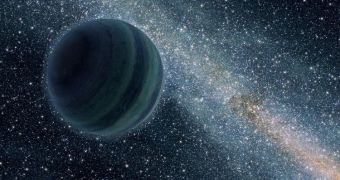According to the conclusions of a new scientific study, a planet about four times the size of Earth may lurk in the solar system, beyond the orbit of Neptune. Its existence was proposed based on observations of other, small bodies in the area, which appear to be constantly perturbed by something.
Some astronomers believe that such a world could help explain the peculiar motions of objects in the Kuiper Belt, beyond the dwarf planet Pluto. These celestial bodies are taking abnormal courses through space, which cannot be readily explained through other phenomena or gravitational interactions.
Though it may seem impossible that an object that large has not been observed until now, experts say that Earth-based telescopes would be unable to resolve such a distant object directly. On the other hand, the existence of this proposed planet has not yet been confirmed, Space reports.
Speaking at a meeting of the American Astronomical Society earlier this month, famed astronomer Rodney Gomes, from the national Observatory of Brazil in Rio de Janeiro, presented a series of complex computer models, indicating the existence of this world as a genuine possibility.
Experts present at the meeting said that more studies were needed in order to actually confirm this world exists, but added that Gomes presented a strong case for this previously hidden planet. The models also included the dwarf planet Sedna.
Since it was first discovered, this object has exhibited anomalous trajectories beyond Neptune's orbit, which astronomers cannot explain even now. A host of other objects, located close to Sedna, exhibit similar deviations from the courses astronomers expected them to take based on existing theories.
Gomes' simulations indicate that the new world would be located far beyond the orbit of Pluto. Due to its size, it would exert a strong influence on trans-Neptunine objects, but only a minimal one on the four gas and ice giants, and a negligible one on the inner, rocky worlds.
A Neptune-sized ice giant orbiting about 225 billion kilometers (140 billion miles) away from the Sun could account for these disruptions. Alternatively, a Mars-sized rocky world in a highly elongated orbit beyond Pluto could exert a similar influence.
The newly proposed world may have developed in the solar system along with the other planets, and then gradually move away from the Sun, or may have been captured by the Sun after being ejected from its own star system, billions of years ago.
“Rodney Gomes is actively seeking further evidence and I await his findings with interest! He has taken on a difficult task, but is taking the right approach. It is definitely a high risk, high reward, situation – a discovery of a new planet would be spectacular!” comments University of Maryland astronomer, Douglas Hamilton.

 14 DAY TRIAL //
14 DAY TRIAL //